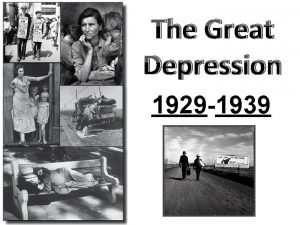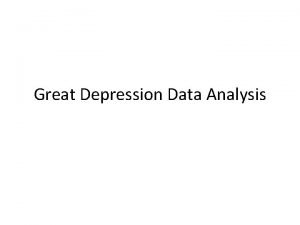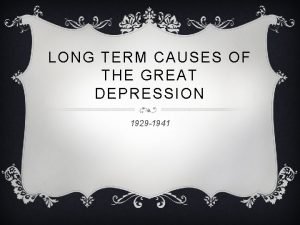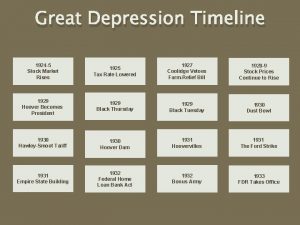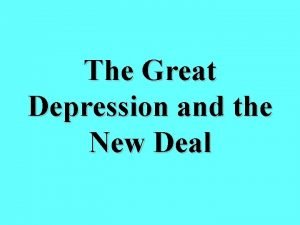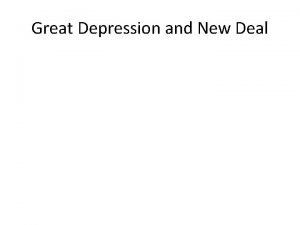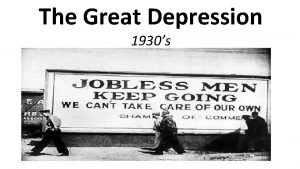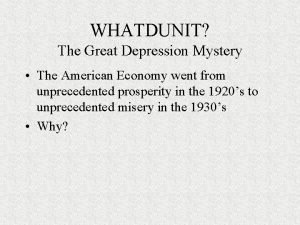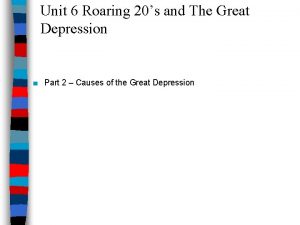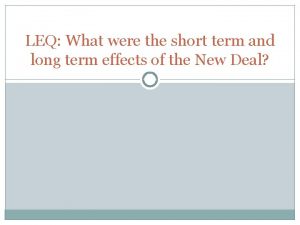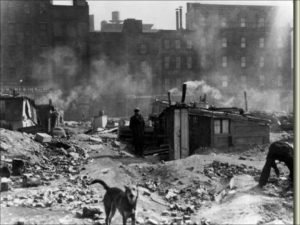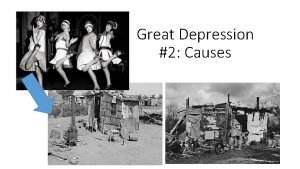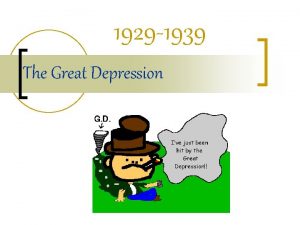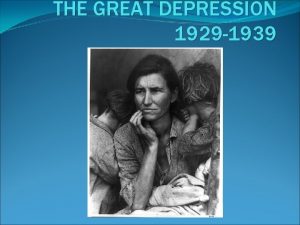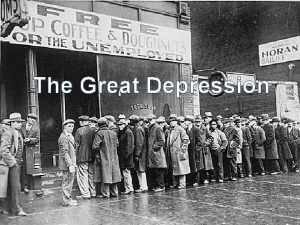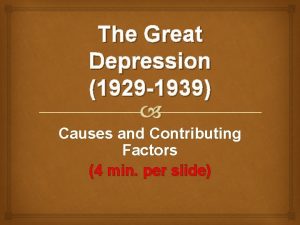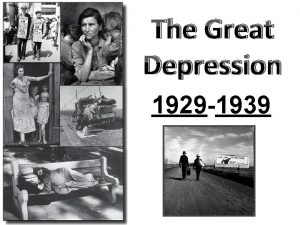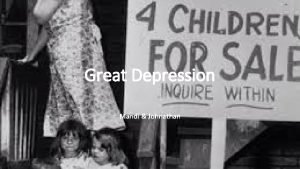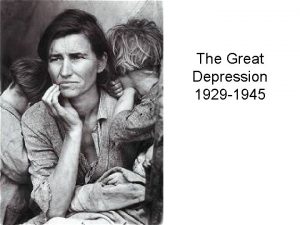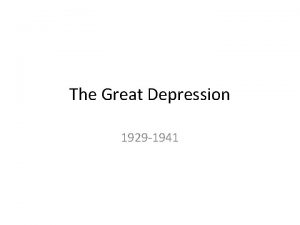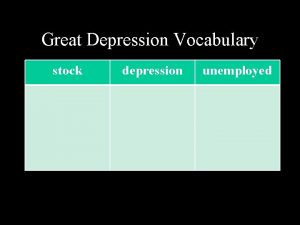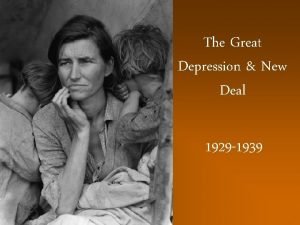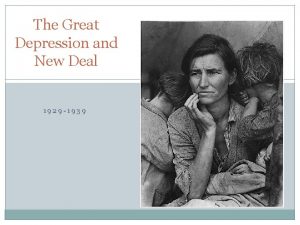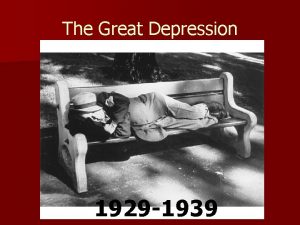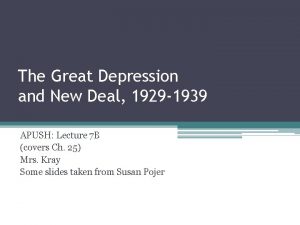The Great Depression 1929 1939 Causes of the
























- Slides: 24

The Great Depression 1929 -1939

Causes of the Great Depression Like WWI, there is the one event that sparked the Depression but there were also underlying causes: • 1. The 1920 s was so prosperous that there was an overproduction of goods: people were making more than they were buying - as sales decreased, people were fired - as people lost their jobs, they bought less goods. • 2. The demand for Canadian wheat dropped as Europe’s land recovered after WWI. • 3. USA put tariffs (taxes) on all imported goods. People wanting to sell goods to Americans had to pay extra taxes. This hit Canada particularly hard.

Black Tuesday: October 29, 1929 • Consumption (or buying) in the 1920 s was often done “on the margin” This meant that because the economy was so good, banks were letting people buy stocks without having a down payment. People even used houses or cars as collateral. • Everyday people were getting involved in stocks – it was no longer just the rich businessmen. This rush of sales increased stock prices. Some people saw this as a good chance to make money by selling their stocks while prices were high. • Panic hit. Once the rich businessmen started to sell, everyone decided to sell. As people sold their stocks, prices dropped dramatically. People could not find buyers for their stocks and they lost everything! Those that were hit particularly hard were those that had bought stocks without really being able to afford them.


n n Eventually, this mad rush to sell stocks resulted in the market crash on Black Tuesday. Both the New York and Toronto Stock Exchanges closed. People were left with stocks that were worthless and banks that were demanding payment.

n In a matter of minutes, families were left with nothing. Even their houses were taken from them by the banks.

Sound familiar? • The housing crisis that is currently going on in North America has also led to a financial crisis. • Because the economy had been going so well, banks were giving out mortgages to people that had no down payment or lacked steady income. They were given mortgages “on the margin” too. • As interest rates increased, people could not afford their mortgage payments. They were forced to sell their homes for less than they bought them, leaving them owing the banks hundreds of thousands of dollars.

• As the number of people owing the banks increased, the less money the banks had. • Banks then have to demand even more from their clients, causing businesses to go under (eg Linens N Things) or the banks to collapse themselves • This culminates in the global credit crunch we are feeling now. Moreover, people are worried about their money and are buying less. As people buy less, businesses suffer, unemployment increases.


Are we in a Depression? • • Some have coined the term “The Great Recession” for what is going on now. The financial crisis were are experiencing is not anywhere near as bad as the Great Depression – why?

Government then and now • • • During the 1930 s the world governments had a policy of laissez-faire or “let be” This meant that the government really did not get involved in the market, nor in social support for its citizens. Today, governments offer welfare, social security, and (in Canada) universal health care. These social “safety nets” prevent poverty experienced during the 1930 s Moreover, governments are willing to provide banks with bailout packages eg Bush gave $7 billion to US banks.

Canada in the 1930 s • Canada was hit particularly hard by the Depression because of problems in the Prairies • At the same time as the market crash was happening, AB, Sask, and Man. were hit by the “Dust Bowl”

The Prairies • The wheat fields were hit with the worst drought ever seen (no rain) • The dry land was blown around in huge wind storms leading to the name “dust bowl” • This was made worse by a huge plague of grasshoppers that ate any crops that grew. • Most farmers could not support their families and had to sell their farms and move elsewhere

Widespread Suffering • Mass unemployment created poverty the likes of which Canada had never seen. • Parents could not afford to send their children to school, families could not eat, no one could afford transportation • Men resorted to “riding the rails” to travel from city to look for jobs.

Some men even rode under the train and just clung to the rods underneath!

• • • So many men could no longer find jobs and felt deep shame about not being able to support their families. As a result, the incidence of alcoholism and suicide sky-rocketed. Any income that was earned went “to the bottle” leaving mothers, children, and sober men to stand in long lines at food banks. These food banks usually were based on donations by church groups.


Bread Lines Canadians that relied on food vouchers and food banks were said to be on “pogey” – the term for gov’t assistance.

What is the Gov’t doing during all of this? • Well, not much. Mackenzie King was PM when the market crashed. He though that the crash would be short lived. He also thought that it was not the federal gov’t job to assist the people. King was once quoted as saying that he wouldn’t give “a five-cent piece” to a Tory provincial gov’t. Obviously the PM became very unpopular and was replaced by RB Bennett in the 1930 election.

RB Bennett >Bennett was not particularly in favour of gov’t assistance either but did eventually give $20 million to the provinces to create work programs as part of his “New Deal. ” He also raised tariffs of Cdn goods, which actually did more harm than good- other countries no longer bought Cdn products! > To keep young men busy, Bennett created work camps. Unfortunately, these camps were more like prisons. The conditions were horrible and the pay was pathetic.

Work Camp

Canadians Respond! • The conditions of the work camps, combined with the difficulty of getting pogey resulted in the “On to Ottawa Trek” • In 1935, a group of men in Vancouver hopped on trains and were on a mission to get to Ottawa and have words with the Prime Minister. More people joined them as they went, but they were stopped in Regina. Only eight men were allowed to continue.

• Things went poorly with the PM. Namecalling and shouting occurred. In response, fighting broke out in Regina. One man was killed and many injured. • Later that year there was another election, Bennett was replaced by King.

• King’s views had not changed much, and by 1937 work camps were closed and pogey was even harder to get. Canada was in a bleak situation and it was only getting worse. Dust Bowl and Depression clip
 Stock market cartoon
Stock market cartoon Rrr great depression
Rrr great depression Great depression causes
Great depression causes What were the long term causes of the great depression
What were the long term causes of the great depression Black tuesday political cartoon
Black tuesday political cartoon Great depression vocabulary
Great depression vocabulary Anxiety in the heart of man causes depression
Anxiety in the heart of man causes depression Hoovervilles great depression
Hoovervilles great depression Five effects of the great depression
Five effects of the great depression Hardship and suffering during the depression
Hardship and suffering during the depression Chapter 33 the great depression and the new deal
Chapter 33 the great depression and the new deal Great depression timeline
Great depression timeline Hawley smoot tariff apush
Hawley smoot tariff apush Pantoum of the great depression
Pantoum of the great depression Great depression
Great depression Hoover and roosevelt compare and contrast
Hoover and roosevelt compare and contrast Chapter 22 the great depression begins
Chapter 22 the great depression begins Laissez faire great depression
Laissez faire great depression Poverty during the great depression
Poverty during the great depression 2014 brain wrinkles answer key
2014 brain wrinkles answer key Overspeculation great depression
Overspeculation great depression Great depression
Great depression The great depression outline
The great depression outline The great depression leq
The great depression leq What was hoover’s response to the depression?
What was hoover’s response to the depression?

